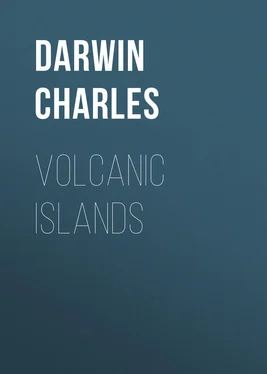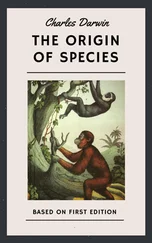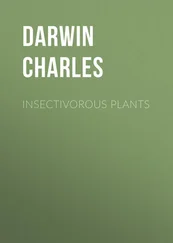Charles Darwin - Volcanic Islands
Здесь есть возможность читать онлайн «Charles Darwin - Volcanic Islands» — ознакомительный отрывок электронной книги совершенно бесплатно, а после прочтения отрывка купить полную версию. В некоторых случаях можно слушать аудио, скачать через торрент в формате fb2 и присутствует краткое содержание. Жанр: foreign_antique, foreign_prose, на английском языке. Описание произведения, (предисловие) а так же отзывы посетителей доступны на портале библиотеки ЛибКат.
- Название:Volcanic Islands
- Автор:
- Жанр:
- Год:неизвестен
- ISBN:нет данных
- Рейтинг книги:5 / 5. Голосов: 1
-
Избранное:Добавить в избранное
- Отзывы:
-
Ваша оценка:
- 100
- 1
- 2
- 3
- 4
- 5
Volcanic Islands: краткое содержание, описание и аннотация
Предлагаем к чтению аннотацию, описание, краткое содержание или предисловие (зависит от того, что написал сам автор книги «Volcanic Islands»). Если вы не нашли необходимую информацию о книге — напишите в комментариях, мы постараемся отыскать её.
Volcanic Islands — читать онлайн ознакомительный отрывок
Ниже представлен текст книги, разбитый по страницам. Система сохранения места последней прочитанной страницы, позволяет с удобством читать онлайн бесплатно книгу «Volcanic Islands», без необходимости каждый раз заново искать на чём Вы остановились. Поставьте закладку, и сможете в любой момент перейти на страницу, на которой закончили чтение.
Интервал:
Закладка:
DESCRIPTION OF THE CALCAREOUS DEPOSIT OVERLYING THE FOREGOING VOLCANIC ROCKS.
This stratum is very conspicuous from its white colour, and from the extreme regularity with which it ranges in a horizontal line for some miles along the coast. Its average height above the sea, measured from the upper line of junction with the superincumbent basaltic lava, is about sixty feet; and its thickness, although varying much from the inequalities of the underlying formation, may be estimated at about twenty feet. It consists of quite white calcareous matter, partly composed of organic debris, and partly of a substance which may be aptly compared in appearance with mortar. Fragments of rock and pebbles are scattered throughout this bed, often forming, especially in the lower part, a conglomerate. Many of the fragments of rock are whitewashed with a thin coating of calcareous matter. At Quail Island, the calcareous deposit is replaced in its lowest part by a soft, brown, earthy tuff, full of Turritellae; this is covered by a bed of pebbles, passing into sandstone, and mixed with fragments of echini, claws of crabs, and shells; the oyster-shells still adhering to the rock on which they grew. Numerous white balls appearing like pisolitic concretions, from the size of a walnut to that of an apple, are embedded in this deposit; they usually have a small pebble in their centres. Although so like concretions, a close examination convinced me that they were Nulliporae, retaining their proper forms, but with their surfaces slightly abraded: these bodies (plants as they are now generally considered to be) exhibit under a microscope of ordinary power, no traces of organisation in their internal structure. Mr. George R. Sowerby has been so good as to examine the shells which I collected: there are fourteen species in a sufficiently perfect condition for their characters to be made out with some degree of certainty, and four which can be referred only to their genera. Of the fourteen shells, of which a list is given in the Appendix, eleven are recent species; one, though undescribed, is perhaps identical with a species which I found living in the harbour of Porto Praya; the two remaining species are unknown, and have been described by Mr. Sowerby. Until the shells of this Archipelago and of the neighbouring coasts are better known, it would be rash to assert that even these two latter shells are extinct. The number of species which certainly belong to existing kinds, although few in number, are sufficient to show that the deposit belongs to a late tertiary period. From its mineralogical character, from the number and size of the embedded fragments, and from the abundance of Patellae, and other littoral shells, it is evident that the whole was accumulated in a shallow sea, near an ancient coast-line.
EFFECTS PRODUCED BY THE FLOWING OF THE SUPERINCUMBENT BASALTIC LAVA OVER THE CALCAREOUS DEPOSIT.
These effects are very curious. The calcareous matter is altered to the depth of about a foot beneath the line of junction; and a most perfect gradation can be traced, from loosely aggregated, small, particles of shells, corallines, and Nulliporae, into a rock, in which not a trace of mechanical origin can be discovered, even with a microscope. Where the metamorphic change has been greatest, two varieties occur. The first is a hard, compact, white, fine-grained rock, striped with a few parallel lines of black volcanic particles, and resembling a sandstone, but which, upon close examination, is seen to be crystallised throughout, with the cleavages so perfect that they can be readily measured by the reflecting goniometer. In specimens, where the change has been less complete, when moistened and examined under a strong lens, the most interesting gradation can be traced, some of the rounded particles retaining their proper forms, and others insensibly melting into the granulo-crystalline paste. The weathered surface of this stone, as is so frequently the case with ordinary limestones, assumes a brick-red colour.
The second metamorphosed variety is likewise a hard rock, but without any crystalline structure. It consists of a white, opaque, compact, calcareous stone, thickly mottled with rounded, though regular, spots of a soft, earthy, ochraceous substance. This earthy matter is of a pale yellowish- brown colour, and appears to be a mixture of carbonate of lime with iron; it effervesces with acids, is infusible, but blackens under the blowpipe, and becomes magnetic. The rounded form of the minute patches of earthy substance, and the steps in the progress of their perfect formation, which can be followed in a suit of specimens, clearly show that they are due either to some power of aggregation in the earthy particles amongst themselves, or more probably to a strong attraction between the atoms of the carbonate of line, and consequently to the segregation of the earthy extraneous matter. I was much interested by this fact, because I have often seen quartz rocks (for instance, in the Falkland Islands, and in the lower Silurian strata of the Stiper-stones in Shropshire), mottled in a precisely analogous manner, with little spots of a white, earthy substance (earthy feldspar?); and these rocks, there was good reason to suppose, had undergone the action of heat, – a view which thus receives confirmation. This spotted structure may possibly afford some indication in distinguishing those formations of quartz, which owe their present structure to igneous action, from those produced by the agency of water alone; a source of doubt, which I should think from my own experience, that most geologists, when examining arenaceo-quartzose districts must have experienced.
The lowest and most scoriaceous part of the lava, in rolling over the sedimentary deposit at the bottom of the sea, has caught up large quantities of calcareous matter, which now forms a snow-white, highly crystalline basis to a breccia, including small pieces of black, glossy scoriae. A little above this, where the lime is less abundant, and the lava more compact, numerous little balls, composed of spicula of calcareous spar, radiating from common centres, occupy the interstices. In one part of Quail Island, the lime has thus been crystallised by the heat of the superincumbent lava, where it is only thirteen feet in thickness; nor had the lava been originally thicker, and since reduced by degradation, as could be told from the degree of cellularity of its surface. I have already observed that the sea must have been shallow in which the calcareous deposit was accumulated. In this case, therefore, the carbonic acid gas has been retained under a pressure, insignificant compared with that (a column of water, 1,708 feet in height) originally supposed by Sir James Hall to be requisite for this end: but since his experiments, it has been discovered that pressure has less to do with the retention of carbonic acid gas, than the nature of the circumjacent atmosphere; and hence, as is stated to be the case by Mr. Faraday, masses of limestone are sometimes fused and crystallised even in common limekilns. (I am much indebted to Mr. E.W. Brayley in having given me the following references to papers on this subject: Faraday in the "Edinburgh New Philosophical Journal" volume 15 page 398; Gay-Lussac in "Annales de Chem. et Phys." tome 63 page 219 translated in the "London and Edinburgh Philosophical Magazine" volume 10 page 496.) Carbonate of lime can be heated to almost any degree, according to Faraday, in an atmosphere of carbonic acid gas, without being decomposed; and Gay-Lussac found that fragments of limestone, placed in a tube and heated to a degree, not sufficient by itself to cause their decomposition, yet immediately evolved their carbonic acid, when a stream of common air or steam was passed over them: Gay-Lussac attributes this to the mechanical displacement of the nascent carbonic acid gas. The calcareous matter beneath the lava, and especially that forming the crystalline spicula between the interstices of the scoriae, although heated in an atmosphere probably composed chiefly of steam, could not have been subjected to the effects of a passing stream; and hence it is, perhaps, that they have retained their carbonic acid, under a small amount of pressure.
Читать дальшеИнтервал:
Закладка:
Похожие книги на «Volcanic Islands»
Представляем Вашему вниманию похожие книги на «Volcanic Islands» списком для выбора. Мы отобрали схожую по названию и смыслу литературу в надежде предоставить читателям больше вариантов отыскать новые, интересные, ещё непрочитанные произведения.
Обсуждение, отзывы о книге «Volcanic Islands» и просто собственные мнения читателей. Оставьте ваши комментарии, напишите, что Вы думаете о произведении, его смысле или главных героях. Укажите что конкретно понравилось, а что нет, и почему Вы так считаете.












